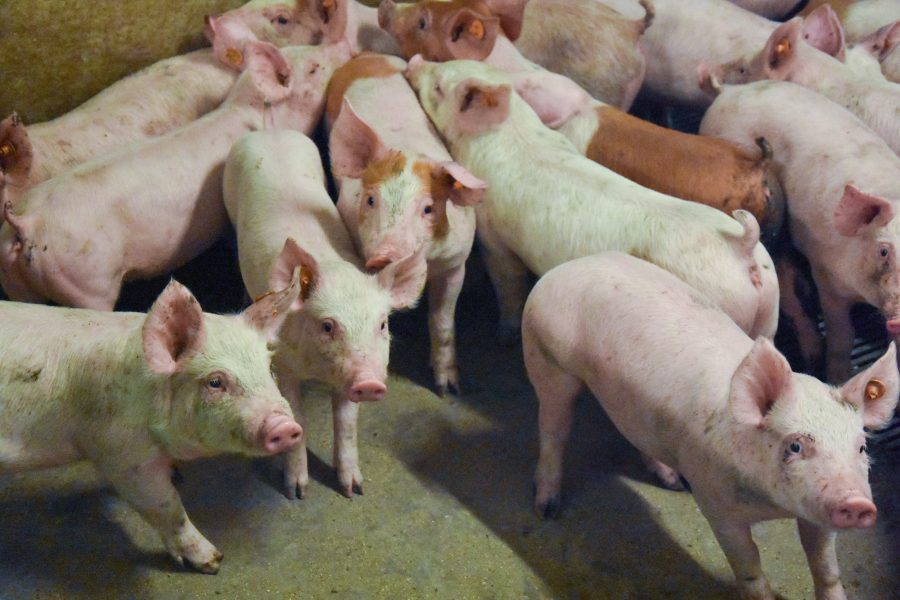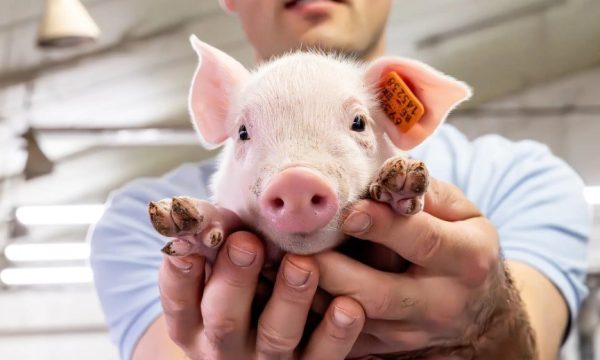Press release Steering meat quality via breed (choice) and sex
"The choice of breed and stress sensitivity of the sire line not only determine to a large extent the technological (e.g. cooking yield of ham) and eating quality (e.g. juiciness and tenderness) of pork, but also the economic picture," says researcher Eline Kowalski at the end of her doctoral study. She investigated how the meat quality and pork processing properties (technological quality) could be measured and improved, taking the profitability of pig production and the recent ban on surgical castration into account.
Within the Belgian Piétrain, the use of homozygous stress negative sire lines results in a higher technological quality without compromising carcass quality or feed conversion. In contrast, eating quality is more influenced by breed choice. Progeny of Duroc sire lines score highest for both technological and eating quality, but lowest for carcass quality and financial return. In male pigs, immunocastration can be used as an alternative to non-anesthetized surgical castration. It prevents the risk of boar taint and results in meat quality equivalent to that of barrows. Extending the time period (8 vs. 4 weeks) between the second vaccination and slaughter does not greatly improve meat quality and instead results in a somewhat lower lean meat percentage and consequently lower financial returns. To properly assess the meat quality of the entire carcass, it is appropriate to perform quality measurements on different muscles. This is because the meat quality of the carcass is not a good predictor for estimating the quality of the ham. Instrumental methods (such as drip loss, intramuscular fat content, shear force, color) can be used to predict the eating quality and the technological quality of the carré and the ham. However, these are ideally complemented by labor-intensive taste panels and cooking efficiency measurements.

Numerous factors influence meat quality
For decades, Flemish meat pig production has been characterized by efficient production with high carcass quality and good animal performance. Meat quality was usually not included in the breeding programs. In recent years, a decrease in eating quality (e.g. juiciness and tenderness) and technological processing quality (e.g. cooking efficiency) was observed. The European intention to stop unanesthetized surgical castration of male piglets makes the issue of lower meat quality even more prominent, as intact boars are even leaner and carry a risk of boar taint. Immunocastration may be an alternative to ensure acceptable meat quality by avoiding boar taint and improving certain meat quality traits.
Improving meat quality is challenging as it is influenced by many factors during rearing, transportation, slaughter of animals and subsequent processing of meat. In addition, meat quality encompasses several characteristics and is not so easily measured. Also within a carcass, muscle pieces (e.g., loin and ham) differ in properties and quality and have different uses, so it is interesting to know the interrelationships. There is also a great demand from the industry to be able to predict meat quality early and easily.
Duroc has best meat quality, Belgian Piétrain scores better on carcass quality
Offspring from sow lines with the highest lean meat percentage give rise to the lowest technological quality in the cooking ham, but the highest financial return in the fattening pigs. If a pig farmer chooses for a certain type of sow, it is of course also important to take into account the reproductive efficiency of the sows.
Despite the negative effects of the stress gene on meat quality, homozygous stress positive boars are still used because they are linked to higher carcass quality. In our study, there was no demonstrable difference in carcass quality and feed conversion between homozygous stress positive and negative sire lines within the Belgian Piétrain, but there was a difference in technological quality. This indicates that if the boar is well-chosen, a switch to homozygous stress negative sire lines can result in a better technological quality without negative financial consequences for the pig farmer within the current payment scheme.
To provide better eating quality in addition to better technological quality, switching to a breed with higher intramuscular fat content might be interesting to pursue. The progeny of the Canadian Duroc scored demonstrably better on both technological and eating quality, but had a demonstrably lower carcass quality and consequently lower financial returns. Within the current payout schedule, pig farmers do not benefit from switching to a higher meat quality breed because their lower carcass quality penalizes them in the slaughterhouse. Fattening pigs from a Duroc finishing line could become profitable if you can create added value for the better meat quality through an adapted sales channel, such as a quality label or short chain sales.
Earlier vaccination of immunocastrates is not good for the wallet - nor the meat quality
Immunocastration, as an alternative to surgical castration, was studied. We determined the effect on meat quality of extending the time interval between the second vaccination and slaughter (8 vs. 6 vs. 4 weeks). The hypothesis was that in male animals vaccinated earlier, testicular function stops earlier, which would then give rise to a relatively higher feed intake and lower lean meat percentage. Therefore, due to the negative relationship between carcass quality and meat quality, we expected a higher intramuscular fat content and water holding capacity in the earlier vaccinated fattening pigs.
The result: when extending the period between 2nd vaccination and slaughter to 8 weeks, the differences in meat quality parameters between vaccination time points (8 vs. 6 vs. 4 weeks) were small. As expected, lean meat percentage decreased as the time between vaccination and slaughter increased, resulting in numerically lower yield per animal. Earlier vaccination also had no effect on the effectiveness of immunocastration within this time interval studied. We thus conclude that extending the time interval between 2nd vaccination and slaughter had a very limited effect on meat quality, but did benefit carcass quality. Therefore, it is recommended to delay the 2nd vaccination until 4 to 6 weeks before slaughter to ensure the best carcass quality and absence of boar taint.
Meat quality measurements of loin are not a good predictor of (cooked) ham quality
The data from our trials were used to determine the extent to which the results of meat quality measurements of pork loin - the most commonly used muscle for measuring meat quality - can be used to predict ham quality. From the data set used, only a weak association between loin and fresh and cooked ham was observed. Consequently, depending on the purpose, measurements for estimation of meat quality of the whole carcass can best be performed on different muscles.
Instrumental measurement methods only partially predict technological and sensory quality
In addition, the extent to which instrumental measurement methods (e.g., pH, color, drip loss) can predict technological (e.g., cooking efficiency of ham) and eating quality (e.g., juiciness and tenderness) was examined. The instrumental parameters of intramuscular fat content, shear force, and drip loss had the greatest influence on the eating quality parameters of juiciness and tenderness. The color of the cooking ham could best predict the technological efficiency of the cooked ham. Unfortunately, these instrumental measurement methods could only explain a small portion of the variation in technological and eating quality. Thus, taste panels and cooking efficiency measurements provide the most valuable information about consumer preferences and the technological quality of the cooked ham. Since taste panels and cooking efficiency measurements are expensive and time consuming compared to instrumental measurements, and instrumental measurements can still explain a small portion of eating and technological quality, the use of instrumental measurements remains of interest. Instrumental measurements can be used in preliminary research and then, if differences in instrumental characteristics are observed, taste panels can be conducted to confirm these results and the relevance of these differences. Thus, the use of both methods is recommended.
On March 31, 2021, Eline Kowalski defended her PhD: Influence of genotype and immunocastration on pork quality. Promoters of the PhD are Prof. Dr. Ir. Stefaan De Smet (UGent), Dr. Ir. Marijke Aluwé (ILVO) and Dr. Ir. Els Vossen (UGent).
These trials were funded by the Agency for Innovation & Enterprise (IWT: 150909) and Flanders' FOOD project proTenderHam (HBC.2017.0495 - AgriFood spearhead cluster ).


